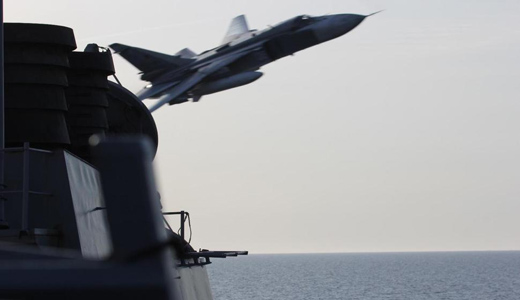
“Aggressive.” “Revanchist.” “Swaggering.” These are just some of the adjectives the mainstream press and leading U.S. and European political figures are routinely inserting before the words “Russia,” or “Vladimir Putin.” It is a vocabulary most Americans have not seen or heard since the height of the Cold War.
The question is, why?
Is Russia really a military threat to the United States and its neighbors? Is it seriously trying to avenge itself for the 1989 collapse of the Soviet Union? Is it actively trying to rebuild the old Soviet empire? The answers to these questions are critical because, for the first time since the 1962 Cuban missile crisis, several nuclear-armed powers are on the edge of a military conflict with fewer safeguards than existed 50 years ago.
Consider the following events:
- NATO member Turkey shoots down a Russian warplane.
- Russian fighter-bombers come within 30 feet of a U.S. guided missiledestroyer, and a Russian fighter does abarrel rollover a U.S. surveillance plane. Several U.S. Senators call for a military response to such encounters in the future.
- NATOand the U.S. begin deploying three combat brigades-about 14,000 troops and their equipment-in several countries that border Russia, and Washington has more than quadrupled its military spending in the region.
- U.S. State Department officials accuse Russia of”dismantling” arms control agreements, while Moscow charges that Washington is pursuing several destabilizing weapons programs.
- Both NATO and the Russians have carried out large war games on one another’s borders and plan more in the future, in spite of the fact that the highly respected European Leadership Network (ELN) warns that the maneuvers are creating”mistrust.”
New dangers
In the aftermath of the Cuban Missile Crisis, the major nuclear powers established some ground rules to avoid the possibility of nuclear war, including the so-called “hot line” between Washington and Moscow. But, as the threat of a nuclear holocaust faded, many of those safeguards have been allowed to lapse, creating what the ELN calls a “dangerous situation.”
According to a recent report by the ELN, since March of last year, there have been over 60 incidents that had “the potential to trigger a major crisis between a nuclear armed state and a nuclear armed alliance.” The report warns that, “There is today no agreement between NATO and Russia on how to manage close military encounters.”
Such agreements do exist, but they are bilateral and don’t include most alliance members. Out of 28 NATO members, 11 have memorandums on how to avoid military escalation at sea, but only the U.S., Canada, and Greece have what are called “Preventing Dangerous Military Activities” (DMA) agreements that cover land and air as well. In any case, there are no such agreements with the NATO alliance as a whole.
The lack of such agreements was starkly demonstrated in the encounter between Russian aircraft and the U.S. The incident took place less than 70 miles off Baltiysk, home of Russia’s Baltic Sea Fleet, and led to an alarming exchange in the Senate Armed Services Committee among Republican John McCain, Democrat Joe Donnelly, and U.S. General Curtis Scaparrotti, soon to assume command of U.S. forces in Europe.
McCain: “This may sound a little tough, but should we make an announcement to the Russians that if they place the men and women on board Navy ships in danger, that we will take appropriate action?”
Scaparrotti: “That should be known, yes.”
Donnelly: “Is there a point…where we tell them in advance enough, the next time it doesn’t end well for you?”
Scaparrotti: “We should engage them and make clear what is acceptable. Once we make that known we have to enforce it.”
For the Americans, the Russian flyby was “aggressive.” For the Russians, U.S. military forces getting within spitting range of their Baltic Fleet is the very definition of “aggressive.” What if someone on the destroyer panicked and shot down the plane? Would the Russians have responded with an anti-ship missile? Would the U.S. have retaliated and invoked Article 5 of the NATO Treaty, bringing the other 27 members into the fray?
Faced by the combined power of NATO, would the Russians-feeling their survival at stake-consider using a short-range nuclear weapon? Would the U.S. then attempt to take out Moscow’s nuclear missiles with its new hypersonic glide vehicle? Would that, in turn, kick in the chilling logic of thermonuclear war: use your nukes or lose them?
Far-fetched? Unfortunately, not at all. The world came within minutes of a nuclear war during the Cuban Missile Crisis and, as researcher Eric Schlosser demonstrated in his book Command and Control, the U.S. came distressingly close at least twice more by accident.
One of the problems about nuclear war is that it is almost impossible to envision. The destructive powers of today’s weapons have nothing in common with the tiny bombs that incinerated Hiroshima and Nagasaki, so experience is not much of a guide. Suffice it to say that just a small portion of the world’s nukes would end civilization as we know it, and a general exchange could possibly extinguish human life.
With such an outcome at least in the realm of possibility, it becomes essential to step back and try to see the world through another’s eyes.
Is Russia really a threat?
Is Russia really a danger to the U.S. and its neighbors? NATO points to Russia’s 2008 war with Georgia and its 2014 intervention in eastern Ukraine as examples of “Russian aggression.”
But from Moscow, the view is very different.
In 1990, U.S. Secretary of State James Baker and German Chancellor Helmet Kohl pledged to then Soviet Premier Mikhail Gorbachev that NATO would not move eastward, nor recruit former members of the East bloc military alliance, the Warsaw Pact.
By 1995, NATO had enlisted Pact members Romania, Hungry, Poland, the Czech Republic, Latvia, Lithuania, Estonia, Bulgaria, Slovakia, and signed on Montenegro this year. Georgia is currently being considered, and there is a push to bring Ukraine aboard. From Moscow’s perspective, NATO is not only moving east, but encircling Russia.
“I don’t think many people understand the visceral way Russia views NATO and the European Union as an existential threat,” says U.S. Admiral Mark Ferguson, commander of U.S. naval forces in Europe.
Most NATO members have no interest in starting a fight with Russia, but others sound like they think it wouldn’t be a bad idea. On April 15, Witold Waszczykowski, the foreign minister of Poland’s right-wing government, told reporters that Russia is “more dangerous than the Islamic State,” because Moscow is an “existential threat to Europe.” The minister made his comments at a NATO conference discussing the deployment of a U.S. armored brigade on Poland’s eastern border.
Is Russia reneging on arms control agreements? The charge springs from the fact that Moscow has refused to consider cutting more of its nuclear weapons, is boycotting nuclear talks, deploying intermediate range nuclear missiles, and backing off a conventional weapons agreement. But again, Moscow sees all that very differently.
From Moscow’s point of view, the U.S. is continuing to spread its network of anti-missile systems in Europe and Asia, which the Russians see as a threat to their nuclear force (as does China). And as far as “reneging” goes, it was the U.S. that dumped the Anti-Ballistic Missile Treaty, not Russia,
The U.S. is also pouring billions of dollars into “modernizing” its nuclear weapons. It also proposes using ICBMs to carry conventional warheads (if you see one coming, how do you know it’s not a nuke?), and is planning to deploy high velocity glide vehicles that will allow the U.S. to strike targets worldwide with devastating accuracy. And since NATO is beefing up its forces and marching east, why should the Russians tie themselves to a conventional weapons treaty?
What about Russia’s seizure of the Crimea? According to the U.S. State Department, redrawing European boundaries is not acceptable in the 21st century-unless you are Kosovo breaking away from Serbia under an umbrella of NATO air power, in which case it’s fine. Residents of both regions voted overwhelmingly to secede.
Georgia? The Georgians stupidly started it.
But if Russia is not a threat, then why the campaign of vilification, the damaging economic sanctions, and the provocative military actions?
First, it is the silly season-American elections-and bear-baiting is an easy way to look “tough.” It is also a tried and true tactic of the U.S. armaments industry to keep their production lines humming and their bottom lines rising. The Islamic State is scary but you don’t need big-ticket weapons systems to fight it. The $1.5 trillion F-35s are for the Russkies, not terrorists.
There are also those who still dream of regime change in Russia. Certainly that was in the minds of the neo-cons when they used the National Endowment for Democracy and Freedom House to engineer-at the cost of $5 billion-the coup that toppled Ukraine into NATO’s camp. The New American Century gang and their think tanks-who brought you Afghanistan, Iraq, Libya and Syria-would love to leverage Russia out of Central Asia.
The reality of “expansionism”
The most frightening aspect of current East-West tension is that there is virtually no discussion of the subject, and when there is, it consists largely of distorted history and gratuitous insults. Vladimir Putin might not be a nice guy, but the evidence he is trying to re-establish some Russian empire, and is a threat to his neighbors or the U.S., is thin to non-existent. His much-discussed 2014 speech at the Valdai International Discussion Club was more common sense than bombast.
Expansionist? Russia has two bases in the Middle East and a handful in Central Asia. The U.S. has 662 bases around the world and Special Operations Forces (SOF) deployed in between 70 and 90 countries at any moment. Last year, SOFs were active in 147 countries. The U.S. is actively engaged in five wars and is considering a sixth in Libya. Russian military spending will fall next year, and the U.S. will out-spend Moscow by a factor of 10. Who in this comparison looks threatening?
There are a number of areas where cooperation with Russia could pay dividends. Without Moscow there would be no nuclear agreement with Iran, and the Russians can play a valuable role in resolving the Syrian civil war. That, in turn, would have a dramatic effect on the numbers of migrants trying to crowd into Europe.
Instead, an April 20 meeting between NATO ministers and Russia ended in “profound disagreements” according to alliance head Jens Stoltenberg. Russian ambassador to NATO, Alexander Grushko said that the continued deployment of armed forces on its borders makes it impossible to have a “meaningful dialogue.”
We are baiting the bear, not a sport that ever ends well.
This article originally appeared at the author’s blog, Dispatches From the Edge.
Photo: In this image released by the U.S. Navy, a Russian SU-24 jet makes a close-range and low altitude pass near the USS Donald Cook Navy destroyer on April 12, in the Baltic Sea. U.S. Navy via AP










